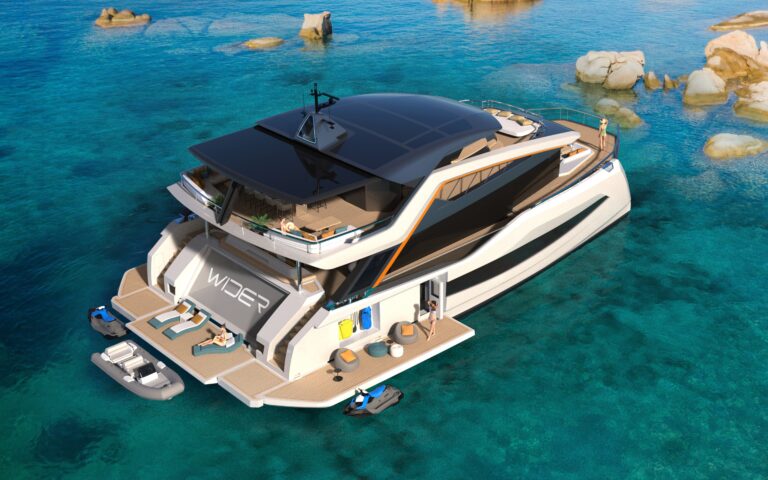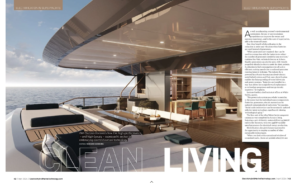As well as enhancing a vessel’s environmental credentials, the use of zero-emissions pro-pulsion can improve the owner and operator experience, and in the case of superyachts, add to the sense of luxury.
One clear benefit of electrification is the reduction in noise and vibration when batteries are used instead of generators.
“When generators are required, they can be used in conjunction with the batteries to re-duce the number of generators needed at any one time,” explains Jim Mair, technical direc-tor at Arksen. Smaller generators can also be used, with vessels propelled silently in electric mode for short periods. A reduction in fuel consumption overall and at efficient cruising speeds due to reduced generator running hours is welcome. The Arksen 85 is powered by a Praxis Automation diesel-electric serial hybrid system and Mair says electrification enables the futureproofing of vessel drivetrain and power systems. “Batteries are installed in a way that allows for straightforward replacement as technology progresses and energy density improves,” he explains.
Luciano Cardini, chief technical officer at Wider Yachts, agrees.
“The powertrain system as a whole is modular, in the sense that the individual macro com-ponents (batteries, generators, electric motors) can be updated independently of each other,” he explains. “Serial yacht architecture can be constantly updated with the latest technology, significantly slowing ‘technological aging’.”
The first unit of the 28m WiderCat 92 composite catamaran was completed in January 2024, featuring a pair of electric motors delivering 500kW each to the thrusters, with two 349kW variable-speed generators for electrical energy production.
Electrification also gives luxury superyachts the opportunity to employ a number of other sustainable technologies.
“When you look at the operational window of a standard yacht, [there are periods when] it’s not used – it’s not always embarking on non-stop journeys like a commercial craft,” explains Iván Salas Jefferson, naval architect and managing partner at Cosmopolitan Yachts. Luxury craft mostly sit at anchor or in a marina, and Jefferson welcomes this chance to streamline power consumption.
“We see it as a huge opportunity to embrace electrification, and specifically solar energy. From the consumption charts and load balances we see, most of this comes from the use of generators, air-conditioning and onboard systems. When you compare the consump-tion – the hotel load with the available power you can get from solar, for example – it makes sense,” he says, adding that electrification also makes sense for shorter trips, or to improve efficiency and redundancy on longer trips.
“By separating the propulsion function from power generation, the serial diesel-electric hy-brid system allows the thermal engines to operate at optimal RPM, resulting in higher effi-ciency and reduced fuel consumption for a given power output,” says Andrea Micheli, chief commercial officer at Southern Wind. The company builds yachts fitted with a diesel-electric serial hybrid propulsion system designed in collaboration with BAE Systems. Chris-tened HybriGen, the system has zero-emissions capability and a hydrogeneration mode to recharge the lithium-ion energy storage when under sail – up to 35kW can be regenerated at speeds of up to 16kts.
Alessandro Rossi, chief technical officer at Azimut|Benetti Group, sees improved efficiency as a key highlight.
“Electrification facilitates higher levels of efficiency and safety, thanks to the redundancy in the power and propulsion sources,” he reports. “The electric motors can provide additional power to the main engines as boosters for acceleration, or fast-charge the battery packs, supporting the hotel mode at anchor. These features reduce the operational hours of endo-thermic engines, enabling the extension of scheduled maintenance periods.”
Rossi also believes hybrid systems and advanced battery technology offer yachts an oppor-tunity to significantly downsize generators, and even make them superfluous.
“At the same time, the adoption of electric grids enables the transition from traditional hy-draulic systems to electric drives and actuators for many auxiliary components such as sta-bilizers, thrusters and actuators, which are notably smaller and lighter. This can result in more spacious and comfortable living areas for passengers,” he says.
Increased comfort
This additional comfort is a big draw in all sectors – but is of particular relevance to the superyacht industry.
“By managing loads and excitation of the gensets, as well as reducing local emissions to a minimum, the main advantage is the increased comfort,” says Giedo Loeff, head of research and development at Dutch vessel building company Feadship. “Engines can be shut down temporarily depending on the battery size, and the engines can be loaded on the most effi-cient points. In the transition to fuel cells and dual-fuel engines, load responses of power systems decrease. Therefore, a PMS and DC grid will enable ideal use of fuel and manage-ment of the lifetime of the power system components.”
“The biggest benefit is the added comfort for guests on board,” agrees Peter Van Der Zanden, general manager of design and development at Heesen Yachts, whose 2017 vessel, Home, was the world’s first fast displacement hull form (FDHF, which enables yachts to save up to 30% in fuel consumption) with hybrid propulsion. “When the yacht is being powered by diesel-electric, you can cruise almost silently at a speed of up to 12kts. A yacht can leave a marina early in the morning and cruise to another destination without guests being woken or disturbed,” he adds.
Heesen is continuing to see a demand, and will deliver its third FDHF hybrid model, the 50m Project Orion, in Q2 2025. Heesen’s drivetrain doesn’t employ battery power, but consists of two diesel engines, a pair of diesel generators and two electric motors that operate sepa-rately or together in various combinations thanks to power management software. Similar to Loeff, Van Der Zanden points to drivetrain lifetime improvements with electrification, say-ing, “A lower workload for the traditional engines results in increased longevity for the entire propulsion system.”
Green spaces
Through the packaging benefits offered by an electrified powertrain, land-based electric ve-hicles often feature improved cabin and stowage space, and this flexibility is also afforded on board a luxury vessel.
“Electrified drivetrains give the designer more flexibility in terms of where generators, batter-ies and key infrastructure are positioned on board, relative to the actual propulsor,” says Mair. “For example, if a client wanted a particular piece of equipment in the engine room of an Arksen 85, we could rearrange the positioning of the generators to an extent to accom-modate this, as they are not mechanically connected to the drivetrain as with a convention-al shaft-driven vessel,” he adds.
“Electric drives provide inherent flexibility, a great advantage in superyacht design,” agrees Loeff. “We can keep all power systems on the tank deck, with accommodation on the lower deck, from bow to transom.”
“High-performing, compact electric motors allow freedom from endothermic engines and their auxiliary systems,” Cardini adds. “The technical rooms can be distributed in strategic areas of the vessel. This allows the designer freedom to choose the most optimal layout.”
Jefferson agrees there is more design flexibility with electrified propulsion: “It definitely gives you more flexibility on the operational side, because you have four different systems to move the boat, especially on a catamaran – two main engines, two e-motors, two small gen-erators and a battery bank. There is a lot of redundancy, which makes sense with long-range operations or standalone time.
“Styling also needs to be considered,” he adds. “Integrating solar panels was a challenge visually, and you have to optimize for different operational ranges, so pushing toward elec-trification does have a big impact. Our lift flybridge roof allowed us to optimize the solar power generation when the flybridge was not in use.”
New approaches
Designing a superyacht around an electrified propulsion unit does require a different per-spective from more conventional craft (see Different by design, opposite), explains Yann Dabbadie, technical manager at Southern Wind.
“A diesel-electric propulsion system is approached completely differently from a standard diesel system. We have high-voltage cables, a glycol cooling system and a CANbus system for information and control,” Dabbadie says, adding that this mostly impacts engine room design. “We have to go into finer details for equipment placement and installation. Aside from components, we also rethink the way the boat is used. Being able to have an intuitive boat to use makes for a more enjoyable experience, allowing the user to use the system’s full potential, regenerating electricity as the yacht is sailing.”
“Hydrogeneration will cut the number of engine hours dramatically during any crossing,” adds Micheli.
For the future, Cardini says, Wider Yachts is keenly following developments in the produc-tion of increasingly safe and efficient batteries: “These use innovative automotive-derived chemistries that allow extremely reduced charging times together with the use of latest-generation electrified docks with CCS sockets.”
Rossi says the Azimut|Benetti Group’s forthcoming R&D activities will focus on leveraging AI to oversee the electrical loads, with a primary goal of augmenting the efficiency of managing its vessels’ electrical requirements: “Our aim is to develop AI solutions that can proficiently and dynamically balance power demands, prioritize energy usage and optimize resource allocation on board.”
Feadship’s R&D activities concern transferring the step toward fuel flexibility (paraffins and alcohols) and the associated engine and fuel cell concepts to projects under development.
“Further R&D will be linked to the actual introduction of these systems, their evolution in cooperation with suppliers, the exploration of full DC systems, and anticipating the next generation of batteries,” Loeff says. “Where will technology development take us? Inherent-ly safe 1,000Wh/l batteries, viable shore power charge networks pushed by FuelEU legisla-tion? Life remains interesting.”
Different by design
When compared with a pure diesel drivetrain, electric and hybrid propulsion units require certain special design requirements to harness the efficiency and other benefits on offer.
“A high-power system is associated with considerable electrical components and cabling,” Feadship’s Giedo Loeff explains. “Bearing in mind superyachts are only outclassed in terms of compactness by naval subs, this is a hell of a job.”
More fundamental considerations include the design of the hull itself.
“In the past, the design of planing yacht hulls and means of propulsion were primarily fo-cused on maximizing high-speed performance,” says Alessandro Rossi at Azimut|Benetti Group. “However, with the emergence of electric and hybrid systems, designers now need to pay close attention to slower cruises, minimizing boat resistance and embracing a differ-ent operational profile that prioritizes efficiency and sustainability alongside speed,” he adds.
“We wanted to make sure that the powertrain functions well within 1.5m waves without in-creasing resistance significantly,” says Iván Salas Jefferson at Cosmopolitan Yachts. “You want to cut through the waves effectively without a skyrocketing resistance curve when you have a 1m wave. It does have a lot of impact on the design.”
Southern Wind’s Yann Dabbadie points to the role regeneration has to play. “To harness the full potential of a diesel-electric vessel, you need to have an efficient regeneration system when sailing. We use a variable pitch propeller coupled to an active pitch control where the pitch and rpm are optimized for any given boat speed. The user can choose how much re-generation is needed, and the control system optimizes the rest.”
Looking at the whole vessel and powertrain design holistically is important, too, says Jeffer-son. “You need to find the right place for batteries, and operate the system in an ecosystem that works well. You have to study the system, not as a standalone, but as the whole eco-system on which the yacht is based.”
This article was originally published in the April 2024 issue of Electric and Hybrid Marine Technology. To view the magazine in full, click here.




